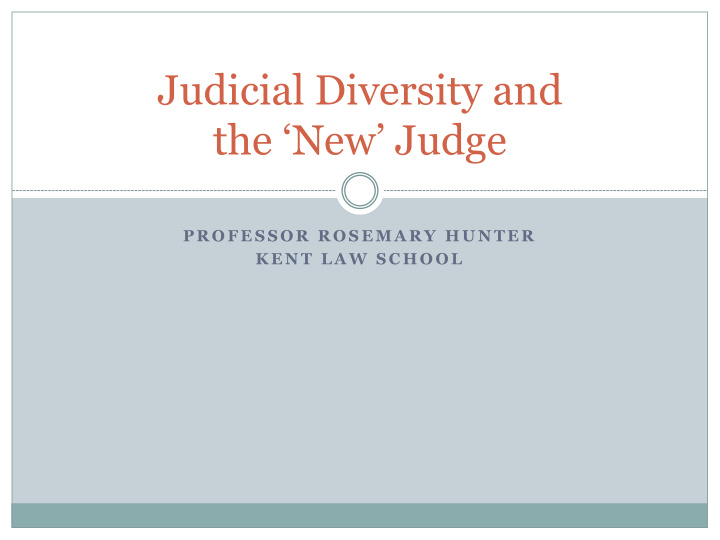



Judicial Diversity and the ‘New’ Judge P R O F E S S O R R O S E M A R Y H U N T E R K E N T L A W S C H O O L
Introduction Growth in size of judiciary Expansion of policy-making role Judicial review Human Rights Act 1998 Neoliberalism Biopolitics Equality and diversity agenda
Neoliberalism Case management Individual docket systems Promotion of settlement Key Performance Indicators (KPIs) Performance improvement groups
Biopolitics Biopower Juridical power Problem-solving courts Therapeutic jurisprudence
The Equality and Diversity Agenda Judicial appointments Select candidates “solely on merit” “have regard to the need to encourage diversity in the range of persons available for selection” Crime and Courts Act 2013: where 2 candidates are of equal merit, may prefer one of them over the other for the purpose of increasing diversity
Diversify recruitment pool at entry level (fee-paid) Progressive narrowing of recruitment pool: Deputy DJ/Recorder District Judge Recorder/District Judge Circuit/Crown Court Judge Recorder Deputy High Court Judge Circuit/Crown Court Judge/Deputy HCJ High Court Judge High Court Judge Court of Appeal Court of Appeal Judge Supreme Court
Qualities and attributes required of all judges: Intellectual capacity Personal qualities An ability to understand and deal fairly Authority and communication skills Efficiency Leadership and management skills
An ability to understand and deal fairly “an awareness of the diversity of the communities which the courts and tribunals serve and an understanding of differing needs” Personal qualities Sound judgement Decisiveness Objectivity Ability and willingness to learn and develop professionally Authority and communication skills Ability to explain the procedure and any decisions reached clearly and succinctly to all those involved Ability to inspire respect and confidence Ability to maintain authority when challenged
Judicial training Induction courses Continuing education – mandatory for salaried District, Circuit and Crown Court judges Optional for High Court judges Judicial performance evaluation Advisory Panel on Judicial Diversity (2010) “judicially led appraisal is key to enabling talented judges from diverse backgrounds to progress in their careers more effectively. Appraisal needs to address diversity specifically so that those with unusual career paths can access the development and opportunities and advice they need to progress”
Ensuring equality before the law for diverse court users Equal Treatment Benchbook (2008?) Fairness in Courts and Tribunals (2012) Age discrimination Children and young people Disability Domestic violence Gender Gender reassignment Interpreters Intermediaries and signing Language and terminology Race, religion and belief Sexual orientation Social exclusion and poverty Unrepresented parties Vulnerable adults
Conclusion Malleson (1999) Senior judges: expanding constitutional role Lower ranks: a “largely social service role” Part-time judges: primarily dispute resolution
Part-time and lower salaried Dispute resolution Social service role Direct interaction with parties Manage timetables Meet KPIs Training Senior appointment Traditional qualities – authority, decisiveness, objectivity Restricted eligibility, statutory consultation, fully formed Exercise juridical power
Recommend
More recommend